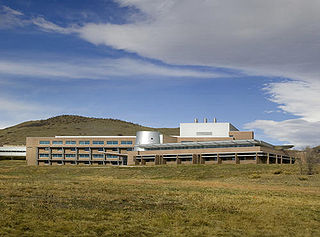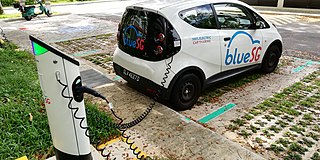Related Research Articles

Renewable energy is energy from renewable natural resources that are replenished on a human timescale. Using renewable energy technologies helps with climate change mitigation, energy security, and also has some economic benefits. Commonly used renewable energy types include solar energy, wind power, hydropower, bioenergy and geothermal power. Renewable energy installations can be large or small. They are suited for urban as well as rural areas. Renewable energy is often deployed together with further electrification. This has several benefits: electricity can move heat and vehicles efficiently, and is clean at the point of consumption. Variable renewable energy sources are those that have a fluctuating nature, such as wind power and solar power. In contrast, controllable renewable energy sources include dammed hydroelectricity, bioenergy, or geothermal power.

A non-renewable resource is a natural resource that cannot be readily replaced by natural means at a pace quick enough to keep up with consumption. An example is carbon-based fossil fuels. The original organic matter, with the aid of heat and pressure, becomes a fuel such as oil or gas. Earth minerals and metal ores, fossil fuels and groundwater in certain aquifers are all considered non-renewable resources, though individual elements are always conserved.

Energy development is the field of activities focused on obtaining sources of energy from natural resources. These activities include the production of renewable, nuclear, and fossil fuel derived sources of energy, and for the recovery and reuse of energy that would otherwise be wasted. Energy conservation and efficiency measures reduce the demand for energy development, and can have benefits to society with improvements to environmental issues.

Wave power is the capture of energy of wind waves to do useful work – for example, electricity generation, water desalination, or pumping water. A machine that exploits wave power is a wave energy converter (WEC).

Environmental technology (envirotech) is the use of engineering and technological approaches to understand and address issues that affect the environment with the aim of fostering environmental improvement. It involves the application of science and technology in the process of addressing environmental challenges through environmental conservation and the mitigation of human impact to the environment.

The National Renewable Energy Laboratory (NREL) in the US specializes in the research and development of renewable energy, energy efficiency, energy systems integration, and sustainable transportation. NREL is a federally funded research and development center sponsored by the Department of Energy and operated by the Alliance for Sustainable Energy, a joint venture between MRIGlobal and Battelle. Located in Golden, Colorado, NREL is home to the National Center for Photovoltaics, the National Bioenergy Center, and the National Wind Technology Center.

Clean technology, also called cleantech or climatetech, is any process, product, or service that reduces negative environmental impacts through significant energy efficiency improvements, the sustainable use of resources, or environmental protection activities. Clean technology includes a broad range of technology related to recycling, renewable energy, information technology, green transportation, electric motors, green chemistry, lighting, grey water, and more. Environmental finance is a method by which new clean technology projects can obtain financing through the generation of carbon credits. A project that is developed with concern for climate change mitigation is also known as a carbon project.

Soft energy technologies may be seen as appropriate renewable technologies. Soft energy technologies are not simply renewable energy technologies, as there are many renewable energy technologies which are not regarded as "soft". The character string including "Soft Energy" is a registered trademark of Soft Energy Controls Inc. in Japan.

The production of renewable energy in Scotland is a topic that came to the fore in technical, economic, and political terms during the opening years of the 21st century. The natural resource base for renewable energy is high by European, and even global standards, with the most important potential sources being wind, wave, and tide. Renewables generate almost all of Scotland's electricity, mostly from the country's wind power.

Renewable energy commercialization involves the deployment of three generations of renewable energy technologies dating back more than 100 years. First-generation technologies, which are already mature and economically competitive, include biomass, hydroelectricity, geothermal power and heat. Second-generation technologies are market-ready and are being deployed at the present time; they include solar heating, photovoltaics, wind power, solar thermal power stations, and modern forms of bioenergy. Third-generation technologies require continued R&D efforts in order to make large contributions on a global scale and include advanced biomass gasification, hot-dry-rock geothermal power, and ocean energy. In 2019, nearly 75% of new installed electricity generation capacity used renewable energy and the International Energy Agency (IEA) has predicted that by 2025, renewable capacity will meet 35% of global power generation.

Renewable energy in the United Kingdom contributes to production for electricity, heat, and transport.

The European Marine Energy Centre (EMEC) Ltd is a UKAS accredited test and research center focused on wave and tidal power development, based in the Orkney Islands, UK. The centre provides developers with the opportunity to test full-scale grid-connected prototype devices in wave and tidal conditions.
Narec, since 2014 known as the National Renewable Energy Centre, is a part of the Offshore Renewable Energy (ORE) Catapult, a British technology innovation and research centre for offshore wind power, wave energy, tidal energy and low carbon technologies. ORE Catapult's head office is in Glasgow, Scotland. The centre operates multi-purpose offshore renewable energy test and demonstration facilities. It is similar to other centres, such as NREL in the US and National Centre for Renewable Energies (CENER) in Spain. The National Renewable Energy Centre is based in Blyth, Northumberland.
The Oyster was a hydro-electric wave energy device that used the motion of ocean waves to generate electricity. It was made up of a Power Connector Frame (PCF), which is bolted to the seabed, and a Power Capture Unit (PCU). The PCU is a hinged buoyant flap that moves back and forth with movement of the waves. The movement of the flap drives two hydraulic pistons that feed high-pressured water to an onshore hydro-electric turbine, which drives a generator to make electricity. Oyster was stationed at the European Marine Energy Centre (EMEC) at its Billia Croo site in Orkney, Scotland until the company ceased trading in 2015.

Marine energy or marine power refers to the energy carried by ocean waves, tides, salinity, and ocean temperature differences. The movement of water in the world's oceans creates a vast store of kinetic energy, or energy in motion. Some of this energy can be harnessed to generate electricity to power homes, transport and industries.
Aquamarine Power was a British wave energy company, founded in 2005 to commercialise the Oyster wave energy converter, a device to capture energy from near-shore waves. The company's head offices were in Edinburgh, Scotland. The company ceased trading in November 2015.
Durham Energy Institute (DEI) is a research institute located within Durham University, England. It was launched in September 2009 for research in the fields of energy technology and society. The current Executive Director is Professor Jon Gluyas.
Oscillating water columns (OWCs) are a type of wave energy converter that harness energy from the oscillation of the seawater inside a chamber or hollow caused by the action of waves. OWCs have shown promise as a renewable energy source with low environmental impact. Because of this, multiple companies have been working to design increasingly efficient OWC models. OWC are devices with a semi-submerged chamber or hollow open to the sea below, keeping a trapped air pocket above a water column. Waves force the column to act like a piston, moving up and down, forcing the air out of the chamber and back into it. This continuous movement forces a bidirectional stream of high-velocity air, which is channeled through a power take-off (PTO). The PTO system converts the airflow into energy. In models that convert airflow to electricity, the PTO system consists of a bidirectional turbine. This means that the turbine always spins the same direction regardless of the direction of airflow, allowing for energy to be continuously generated. Both the collecting chamber and PTO systems will be explained further under "Basic OWC Components."
References
- ↑ Falcão, António F. de O. (2009). "Wave energy utilization: A review of the technologies". Renewable and Sustainable Energy Reviews. 14 (3): 899–918. doi:10.1016/j.rser.2009.11.003.
- ↑ "The Masuda Device". daedalus.gr. Archived from the original on March 30, 2010. Retrieved 2009-12-21.
- ↑ "Give us a wave!". www.unep.org. Retrieved 2009-12-21.
- ↑ Wengenmayr, Roland; Bührke, Thomas, eds. (2008). Renewable energy: sustainable energy concepts for the future . Wiley-VCH. ISBN 978-3-527-40804-7.